The purslane plant (Portulaca), which is also called dandur, is part of the Purslane family. In nature, it is found in the Northern Hemisphere, or rather, in areas with a tropical climate. According to data taken from various sources, this genus includes 100-200 species.
Purslane prefers to grow on sandy moist soil along the banks of various water bodies, including rivers, and it can also be found in fields, orchards and vegetable gardens. In the genus, the name comes from the word "portula", which translates from Latin as "small gate, collar", this is due to the fact that the seed capsule of the plant opens like miniature doors. In middle latitudes, such a flower is called a "rug". Back in the Middle Ages, purslane was very popular in Europe. However, it was most often grown by the British, while at first they grew it as a vegetable garden, not a garden crop. Only 1 species is cultivated by gardeners, namely: large-flowered purslane (Portulaca grandiflora).
Content
Brief description of cultivation
- Landing... Seeds are sown on seedlings in April, and grown seedlings are planted in open soil in June.
- Bloom... It starts in June and ends in the middle of the fall.
- Illumination... Needs lots of bright sunlight.
- Priming... Grows well on rocky or sandy soil, which should be dry and poor.
- Watering... Systematic. Its abundance is dependent on weather conditions and can range from sparse to moderate.
- Fertilizer... Does not need additional feeding.
- Reproduction... Seeds.
- Harmful insects... Aphid.
- Disease... It is highly resistant to disease, but can be affected by a disease caused by the fungus Albugo portulaceae.
- Properties... This medicinal plant has an antiparasitic effect.
Purslane features
In mid-latitudes, purslane is cultivated by gardeners as an annual, since it is not able to winter in open ground, even under cover. The height of the bush is no more than 0.3 meters. The root of the flower is branched and spindle-shaped. Brown shoots are juicy and branched, they are decorated with fleshy leaf plates that are hollow inside, their shape can be cylindrical or similar to an oblate egg.During flowering, which is observed in June-September, flowers appear on the bush of yellow, white and dark red. The life span of one flower is only 1 day, by the evening it already fades. However, due to the fact that the bloom is very lush, it can seem that it lasts continuously. The fruit is a polyspermous spherical box. In addition to garden purslane, which is cultivated in pots, in flower beds, in hanging containers and baskets, in the garden you can often find vegetable purslane, or garden purslane, which is considered both a weed and a healing herb, as well as a salad plant.
Growing purslane from seeds
Sowing
Most gardeners find it best to grow purslane through seedlings. However, gardeners disagree on when it is best to start sowing seeds. Someone claims that sowing seeds should be done in the last days of February or the first - in March, but in this case the seedlings will need additional lighting. Other equally experienced gardeners are sure that there is no hurry, and it is better to sow purslane in April, since at this time the daylight hours are already becoming longer, and natural light is enough for young plants.
Before proceeding with the direct sowing of purslane, it is necessary to prepare a suitable substrate for this. The fact is that any ready-made soil mixture sold in a specialized store contains peat, which slows down the germination of the seeds of this plant. To prepare a suitable substrate, combine garden soil with sand in a ratio of 1: 5. Mix everything well and disinfect the mixture by igniting it in the oven. Take a low container, at the bottom of which there are holes for drainage, and put a layer of small expanded clay or gravel in it. Next, the disinfected substrate is poured, which is spilled with melt water (you can take well-settled water). Spread the seeds evenly over the surface of the soil mixture, the distance between which should be about 10 mm, it is very convenient and easy to do this with a moistened toothpick. The seeds are not sprinkled on top with a substrate, but they are only slightly pressed into the soil mixture. Then a frame is made over the container, on which the film is stretched, as a result you will get a mini-greenhouse. She is transferred to such a well-lit place in which the air temperature does not fall below 22 degrees. However, purslane grows best at a temperature of about 30 degrees.
Seedling care
If everything is done correctly, then the first seedlings should appear after 7-15 days, immediately after that the shelter is removed from the container. Further care for the seedlings is reduced to systematic watering through the pan, for this they use well-settled water. If you see that the seedlings are beginning to actively stretch, it means that they do not have enough light. In this case, it is recommended to provide additional lighting for the seedlings. To do this, it is supplemented with fluorescent lamps in the morning for a couple of hours, and artificial light is also turned on for several hours in the evening. You can also use a simple desk lamp for supplementary lighting. If the day is cloudy, then the lamps are not turned off throughout the day. However, if sowing will be carried out in April, and the seedlings will be on the south-facing window, then they will not need additional lighting.
Picking
After the plants have formed the first pair of true leaf plates, they will need to be picked. For this, small cups are taken, reaching from 70 to 80 mm in diameter, three seedlings are planted in them at once, and try to keep an earthen ball on the roots. And 7 days after they completely take root, they are fed for the first time using a complex mineral fertilizer.After that, the bushes are fed regularly once every 1–1.5 weeks until the very transplant to a permanent place.
Planting a purslane in open ground
What time to plant
Purslane is planted in open ground around the first half of June, when the threat of return frosts has passed. Doing this earlier does not make any sense, since if it is colder than 10 degrees outside, then leaves will begin to fly from the bushes.
For planting such a plant, a well-lit and elevated area is chosen. Remember that if you plant such a flower even in a small partial shade, it will not bloom. And in the event that a place is chosen for planting in a lowland where water stagnation is often observed, or where groundwater is located very close to the surface of the site, then the roots of the bushes can rot, which will lead to the death of the purslane. Sandy poor soil is best suited for growing such a flower, but if the bushes are planted in fertile soil, then they will begin to actively increase the green mass to the detriment of flowering.
Landing rules
Planting in open soil is recommended only after the plants have formed from 10 to 15 true leaf plates and several buds. When planting seedlings, it should be borne in mind that the distance between the bushes should be at least 15–20 centimeters. After planting the plants in the ground, for the first two or three days they are provided with daily watering, especially if the weather is dry. The first flowers will appear on the plant only 6-7 weeks after the seedlings appear.
Purslane care
For normal growth and development, purslane grown outdoors requires systematic watering. Despite the fact that its leaves can retain moisture, if the bushes are watered untimely, this will have an extremely negative effect on flowering. Throughout the growing season, this flower does not need any weeding, feeding, pruning, and you also don’t have to loosen the soil surface near the bushes. Caring for purslane is reduced only to timely watering.


Watch this video on YouTube
Diseases and pests
Even a novice gardener can grow a purslane, and it is also possible for someone who does not have enough time to care for flowers. There is also nothing difficult in the cultivation of terry purslane, since sowing and caring for it is no different from cultivating large-flowered or garden purslane.
A gardener rarely has problems with such a flower, because it is highly resistant to both diseases and harmful insects. But in those years when a large number of aphids attack gardens, purslane may also suffer from it. In order to get rid of such a sucking pest, experts advise resorting to the help of an insecticidal preparation. For example, Actellik effectively fights aphids, with a solution of which purslane needs to be treated, if necessary, re-spraying is carried out after 7 days.
Rarely enough, purslane can still infect the Albugo portulaceae mushroom. In this case, the stems of the diseased plant are deformed, and specks form on its foliage. All affected parts will need to be cut off, after which the bushes are treated with a copper-containing fungicidal agent.
Post-flowering care
Seed collection
Regularly pick off all flowers that have begun to fade from the bushes and remember that if they dry up, then because of them you will not be able to notice the ripe fruit in time, which can open at any time, and its seeds will fall on the ground. In warm, dry weather after pollination, seed maturation will be complete in about 15 days. But if it is quite cool outside in summer and autumn, then the ripening of seeds can take 30 days. In addition, you need to take into account the fact that the seeds that you have just collected will become viable only with the onset of next spring, but they retain good germination for 3 years.
Wintering
In the middle latitudes, garden purslane in the open field freezes out in winter. In this regard, in the autumn, when the bushes will fade, they are dug up, and the soil is dug up on the site. When starting to grow purslane, remember that it reproduces well by self-seeding. Therefore, having planted it just once, you can admire its spectacular flowering every year.
Useful properties of purslane
Purslane, as a medicinal plant, was known even in the days of Galen and Hippocrates. In those days, people were confident that the seeds of such a plant help cleanse the body, while its foliage was used as an antidote for a snakebite. A gruel was made from the leaf plates, which was used to relieve puffiness from the eyes, and it was also taken internally with wine, which helped to eliminate pain in the bladder, as well as to cure a sore stomach. And Arab healers combined finely chopped leaves of such a plant with wine and used the resulting mixture to relieve erysipelas, remove warts and treat acne.
To date, in official medicine, the antiparasitic properties of such a flower are widely used, and doctors also advise that people who suffer from a mild form of diabetes should include it in their diet.
Types and varieties of purslane with a photo
Large-flowered purslane (Portulaca grandiflora)
It is a perennial plant native to South America, but in mid-latitudes it is cultivated as an annual. The height of such a plant is not more than 0.3 m, since it has lodging shoots. Small fleshy leaf plates are cylindrical in shape. Single flowers, reaching 30–40 mm in diameter, are cup-shaped and can be double or simple. Outwardly, the flowers are similar to a tea rose, and they can be painted in cream, yellow, purple, white, beige or red. There are varieties that have a two-color color. Long bloom - from June to the last days of October.
Popular varieties:
- Double Mix... Terry grade. Most often found on sale as a mixture of purslane seeds.
- Cherry... The height of such a low-growing variety is about 10-12 centimeters, powerful shoots are decorated with double cherry flowers, reaching about 50 mm in diameter.
- Hybrid Cream... Creamy double flowers reach about 50 mm in diameter, with a darker shade in the middle.
- Sunglo... This variety differs from the rest in the largest flowers. They don't close even on a cloudy day, like the Cloudbeater and Sundance varieties.
Garden purslane, or vegetable purslane (Portulaca oleracea)
The height of such an annual plant is about 0.3 m. It reproduces very well by self-sowing. On highly branched shoots, leaf plates of an oblong-clawed shape are located. Yellowish flowers in diameter reach from 0.7 to 0.8 cm.This species grows in groups. Flowering begins in June and ends only at the end of the summer period. It is appreciated for its medicinal properties and good taste.


Watch this video on YouTube

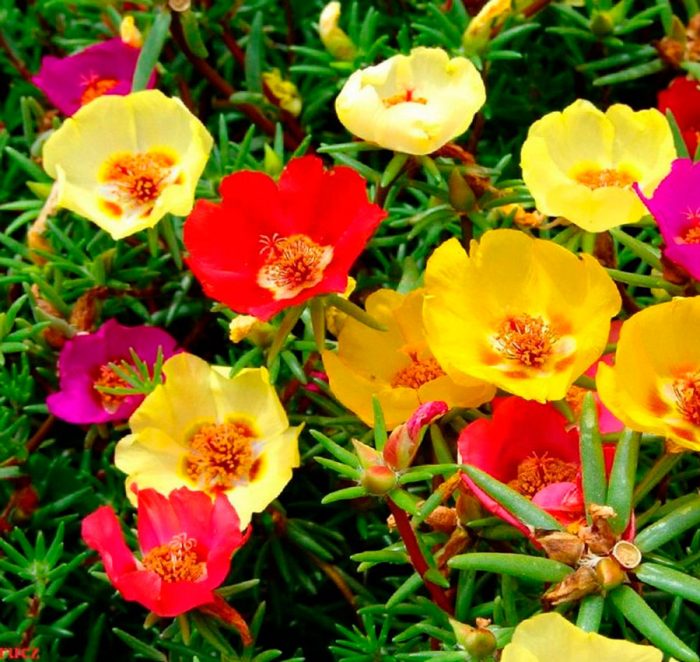
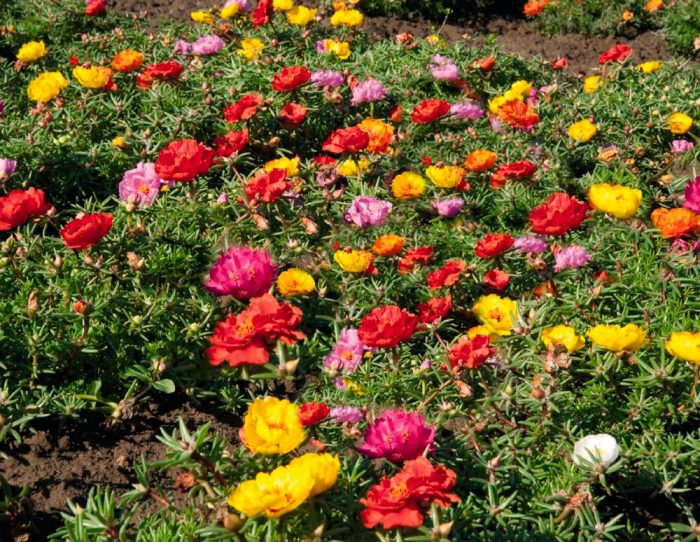
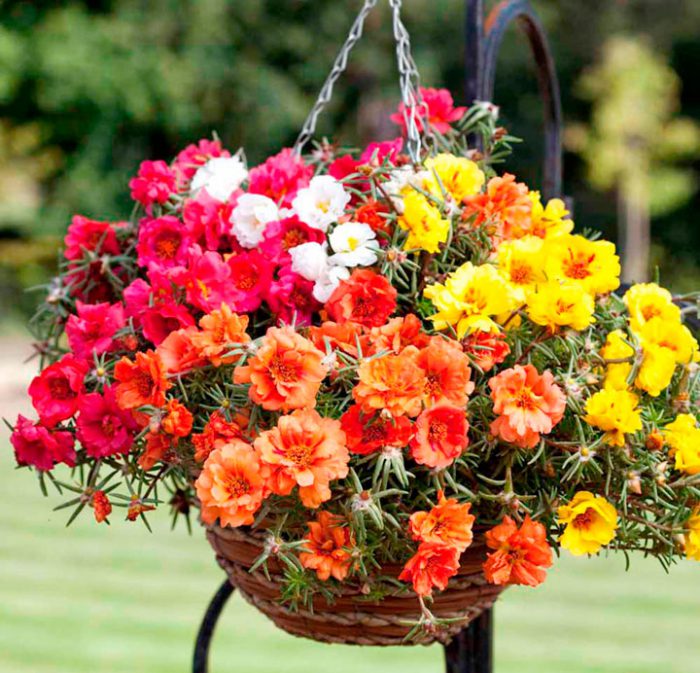
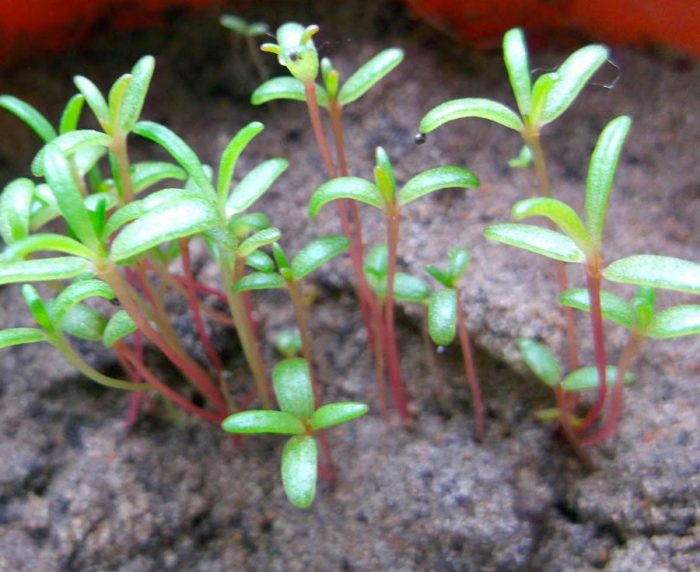

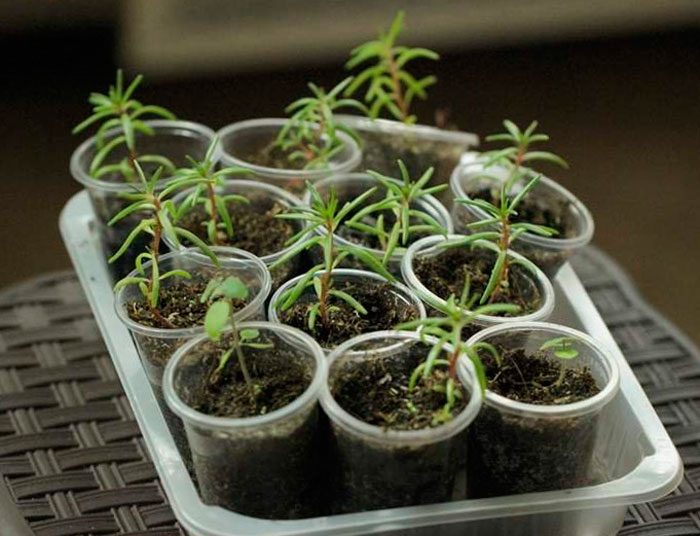
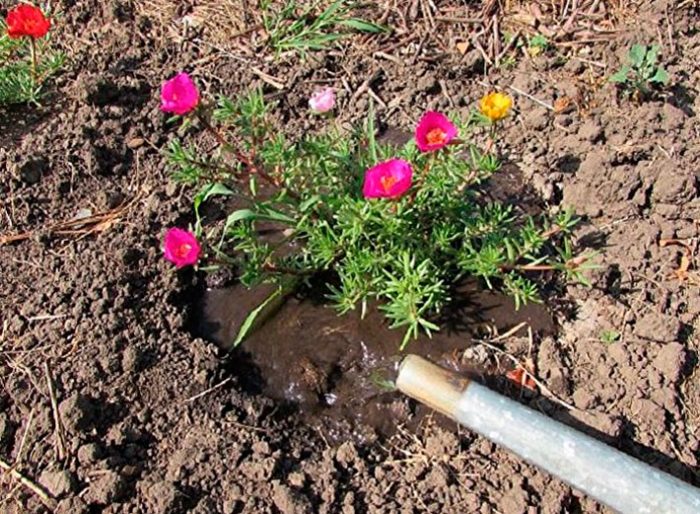
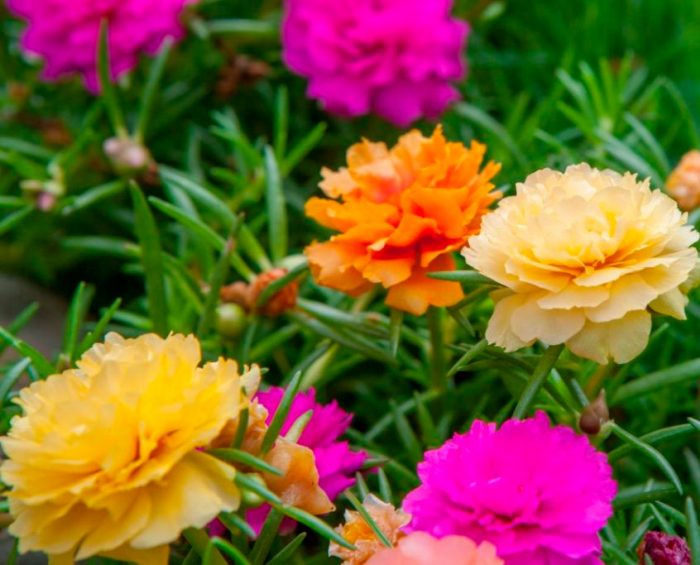
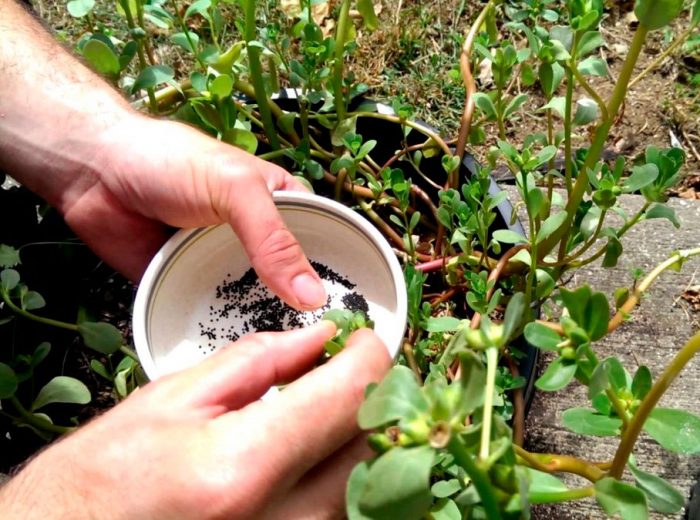
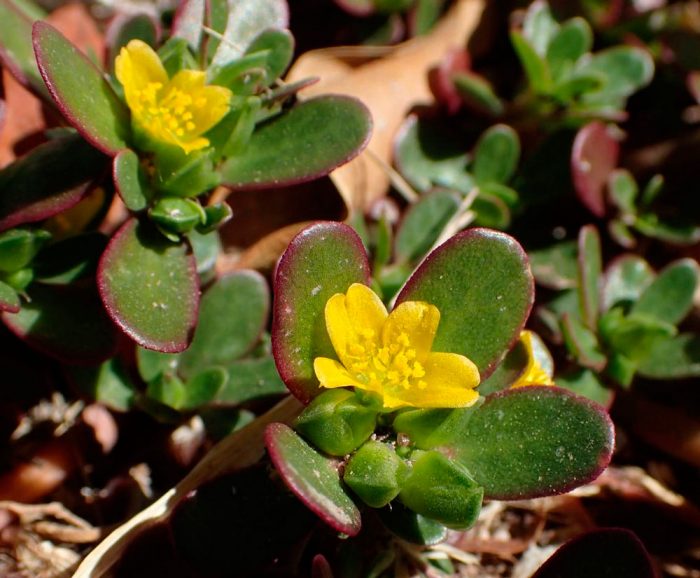
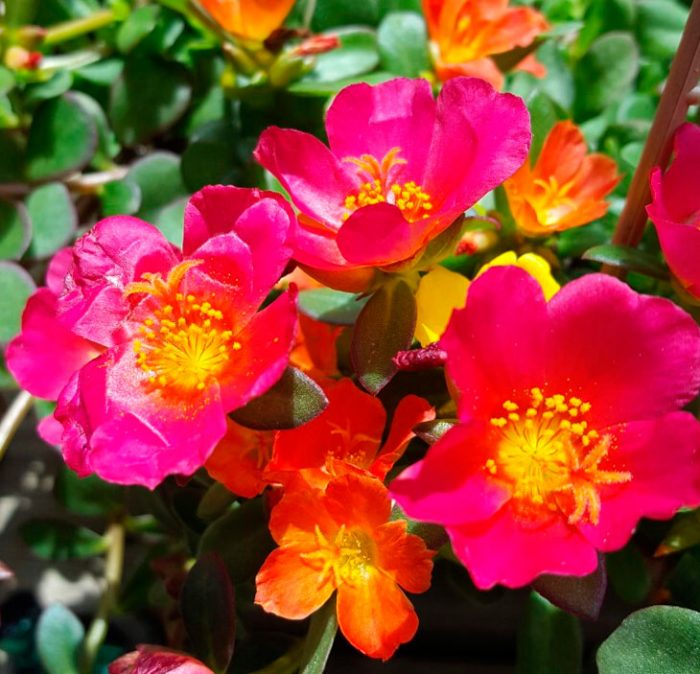

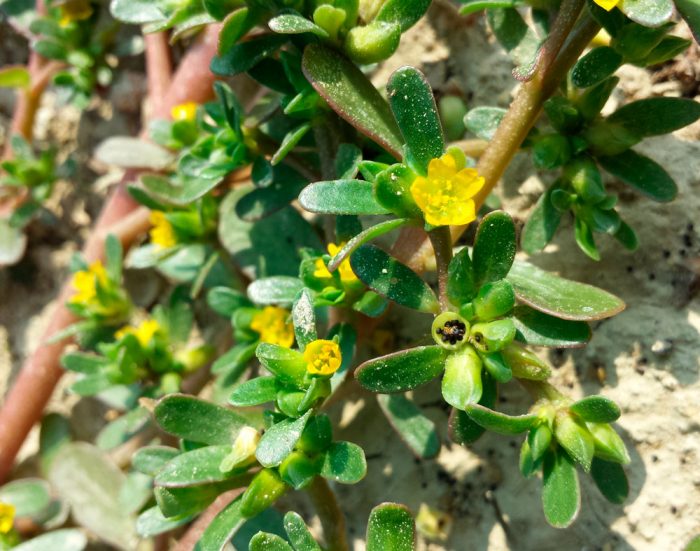










My purslane grows on fertile soil, it blooms beautifully, the bushes are lush, bright. I water it often, as it grows next to moisture-loving plants. I live in the South. So the statement that he only needs poor soil is nonsense!
I agree with Lyudmila: no one has suffered from the fertile soil yet. In addition, it is not clear if you need to dive three plants into a glass, then why are they sitting in the photo one at a time?